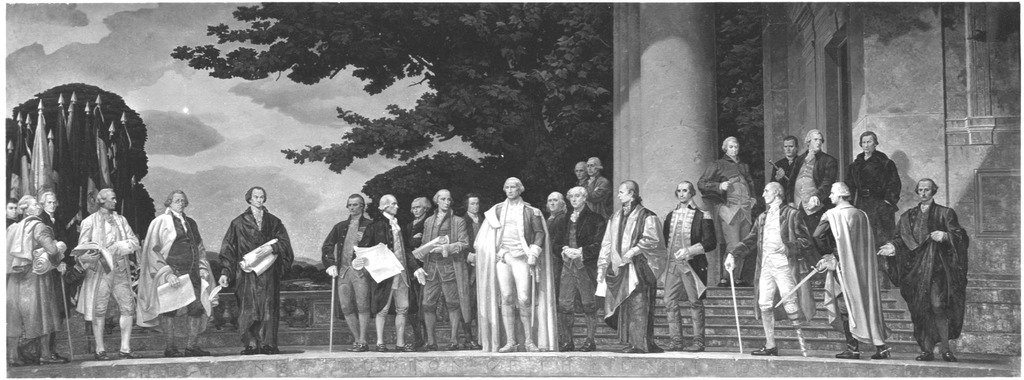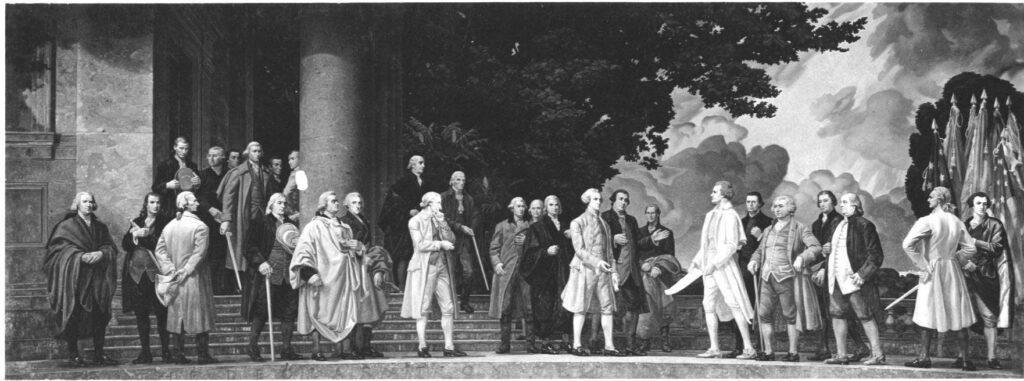The Constitution
by Barry Faulkner

Delegates featured in this painting: Abraham Baldwin (GA), Gunning Bedford, Jr. (DE), William Davie (NC), John Dickinson (DE), Oliver Ellsworth (CT), Benjamin Franklin (PA), Elbridge Gerry (MA), Nathaniel Gorham (MA), Alexander Hamilton (NY), William Samuel Johnson (CT), Rufus King (MA), John Langdon (NH), James Madison (VA), Luther Martin (MD), George Mason (VA), Gouverneur Morris (PA), William Paterson (NJ), Charles Cotesworth Pinckney (SC), Charles Pinckney (SC), Edmund Randolph (VA), George Read (DE), John Rutledge (SC), Roger Sherman (CT), George Washington (VA), and James Wilson (PA).
Artist’s Biography
Barry Faulkner was born in Keene, New Hampshire, in 1881. After briefly attending Harvard University, he studied art in Rome. He returned to New York in 1910 and worked there for several decades before retiring to Keene in the 1960s. He died there at age 85 in 1966.
Faulkner’s 1936 rendition of the Constitutional Convention — coinciding with the opening of the National Archives building — hangs in the Rotunda of that building, along with another mural by Faulkner commemorating the Declaration of Independence. Faulkner depicts the delegates to the Constitutional Convention standing in an ancient Roman setting rather than sitting in a Philadelphia assembly hall. This portrait of the Framers of the Constitution was not well received originally. One commentator said he “must have been reading Roman history and not American history.”
Faulkner’s choice of setting reflects, in part, his affection for outdoor landscapes. Indeed, unlike the other works depicting the signing of the Constitution, this one seems to have been painted with the intention of making the out of doors landscape and Roman architecture the main design elements. There are no tables, no windows, no drapes, and no Philadelphia.
Faulkner was chosen for this project by John Russell Pope, chief architect of the National Archives, who was known as the “last of the Romans.” Pope had also designed both the National Gallery of Art and the Jefferson Memorial.
Twenty years after completing the two murals for the Rotunda, Faulkner told an audience of Daughters of the American Republic in Keene, NH, that the Roman background was chosen to harmonize “with the stark architecture of the Exhibit Hall,” and to “impart a feeling of distance and space.” Using Independence Hall as the background would have been “monotonous across two panels.”
The Painting
The mural does depict Madison delivering the final draft of the Constitution to Washington, so it focuses on the outcome of the Convention. But Faulkner depicts only 25 figures, rather than the 39 delegates who were there on September 17, so this is not really a portrayal of the signing of the Constitution. He also includes the three delegates who declined to sign and three more delegates who left early! Thus depicts only 19 of the 39 signers. What are we to make of this?
An article written by Lester Gorelic and published in the National Archives’ Prologue magazine in 2014 recounts the elaborate review process to which Faulkner’s murals were submitted. The Commission of Fine Arts who supervised this process suggested, at various times, incorporating in the mural portraits of statesmen from the early republic period and even later, so as to give a more “comprehensive” impression of the archives housed in the building. Although this suggestion was eventually rejected, it seems that an historically accurate portrait of the framers alone was never contemplated.
Both Faulkner’s “The Constitution” and “The Declaration of Independence” are massive murals, about 13 feet high by 34 feet long. Commissioned in 1934 and completed in 1936, they were painted in oil on canvas in Faulkner’s studio at Grand Central Station in New York City. They were then transported to Washington, DC, where they were “fastened to the Rotunda’s plaster walls with a mixture of paint, varnish and turpentine.” Faulkner received $36,000 for his work.

Both National Archives murals underwent a restoration and cleaning in the early twenty-first century that cost over $2 million.
